So you’re trying to pick between HeyGen and D-ID for your AI video needs. Smart move, considering both platforms are seriously impressive. But here’s the thing: they’re not really competing for the same crown.
I’ve spent way too much time testing both (my browser history is embarrassing at this point :), and I can tell you they each excel at different things. Think of it like comparing a Swiss Army knife to a precision scalpel. Both are sharp, both are useful, but you wouldn’t use them for the same job.
Let’s break down what actually matters when choosing between these two.
The Core Difference Nobody Talks About
Here’s what most comparisons miss: HeyGen is built for volume. D-ID is built for realism.
HeyGen wants you cranking out polished marketing videos, tutorials, and product demos at scale. It’s got templates for days, supports 175+ languages, and makes it stupidly easy to create content that looks professional. If you need to produce 50 localized videos for different markets by Friday, HeyGen is your friend.
D-ID? Totally different vibe. They’re obsessed with making avatars that look and move like actual humans. Their tech can take a single photo and turn it into a talking person with realistic facial expressions and perfect lip sync. It’s kinda creepy how good it is. They’re all about interactive AI agents and real-time conversations.
Quick reality check: Do you need to make a bunch of videos fast, or do you need one incredibly realistic digital human? Your answer pretty much determines which platform wins.
What Each Platform Actually Does Well?
HeyGen
If you’ve ever wished you could clone yourself to handle all your video content, HeyGen is basically that wish come true.
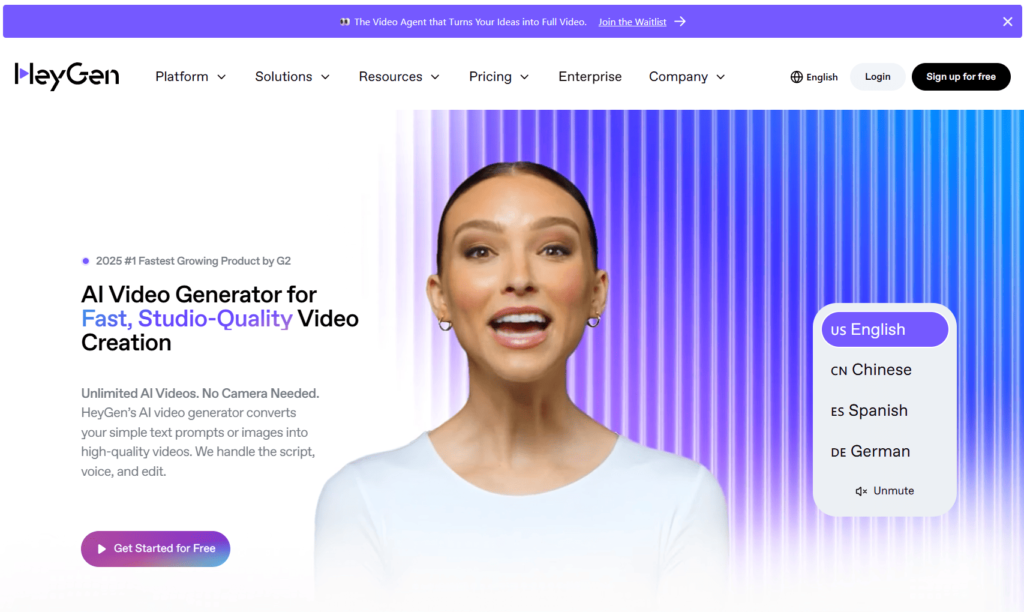
The platform has over 300 AI avatars. Not just “generic business person number 47” either. We’re talking diverse options across ethnicities, ages, and styles. You can even upload footage of yourself and create a custom avatar. (Yes, it’s as weird and cool as it sounds.)
The template library is huge. Promotional videos, explainer content, social media posts, tutorials… you name it, they’ve probably got a template for it. And the drag-and-drop editor makes customization almost too easy. I rebuilt our entire onboarding video series in an afternoon, which would have taken weeks the old way.
Voice options? Over 300 AI-generated voices across those 175+ languages. You can tweak tone, pitch, and speed until it sounds right. They’ve even got voice cloning, though it only works with certain languages right now.
But here’s where HeyGen really shines: integration. It plays nice with Canva, ChatGPT, Zoom, and connects to 5,000+ apps through Zapier. You can literally turn a ChatGPT conversation into a video with your branded avatar. That’s pretty wild.
D-ID
D-ID took a different path. They said “what if we could make AI avatars that don’t look like AI avatars?”
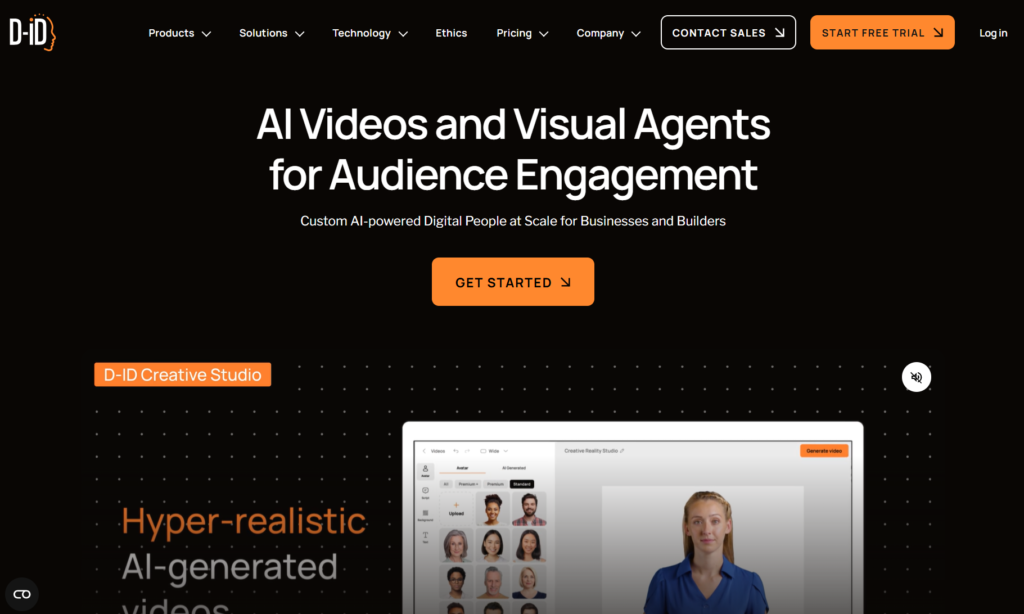
Their Creative Reality Studio is genuinely impressive. Upload any photo (seriously, any photo) and it becomes a talking avatar with realistic expressions and movements. The lip sync is so accurate it’s borderline unsettling. I uploaded a picture of my dog once just to see what would happen. Don’t judge me.
They’ve built their entire platform around this idea of photorealistic digital humans. Their AI agents can hold actual conversations, adapt their facial expressions based on emotion, and feel way more natural than the usual chatbot experience.
The video translation feature deserves its own callout. You can translate existing videos into 100+ languages while maintaining perfect lip sync. Not dubbing. Actual lip movements that match the new language. When I first saw this, I thought it was fake. It’s not.
For developers, D-ID is a dream. Their API lets you embed this tech into basically anything. Customer service portals, educational platforms, virtual assistants… if you can code it, you can add a realistic AI human to it.
Templates: Quantity vs Quality
HeyGen wins on volume. They’ve got templates for everything, and they’re all pretty solid.
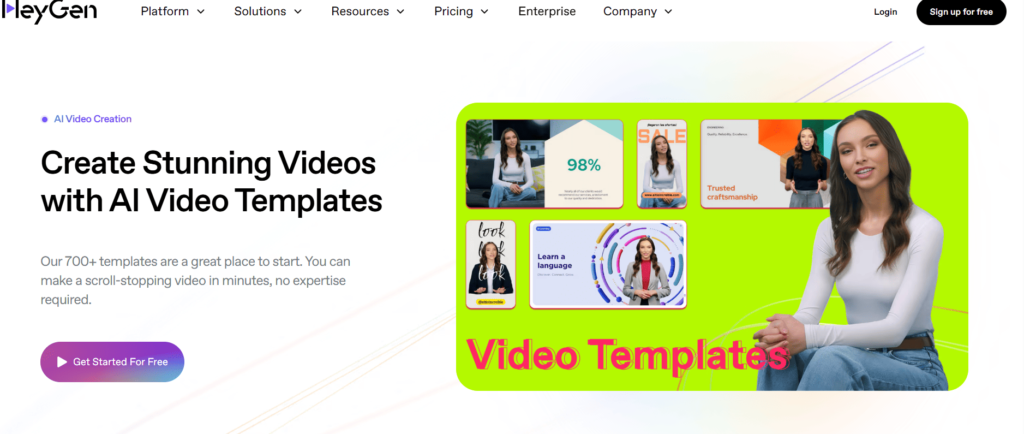
You can customize them quickly, swap in your branding, and you’re done. It’s the IKEA approach: lots of options, easy assembly, looks good enough.
D-ID doesn’t really do templates the same way. Instead, they let you upload your own images and animate them. Want to turn your CEO’s headshot into a talking avatar? Done. Need to bring an illustrated character to life? Also done.
Which approach is better? Depends on whether you value speed or uniqueness. HeyGen gets you to the finish line faster. D-ID gives you something nobody else has.
Scaling Your Video Production
Both platforms handle scale, but differently.
HeyGen built their entire system around bulk production. Their text-to-video feature means you can input scripts and get rendered videos back automatically. Their API automates the whole process, so you can generate hundreds of personalized videos without touching the editor. Businesses use this to create localized content for different markets, all from one script.
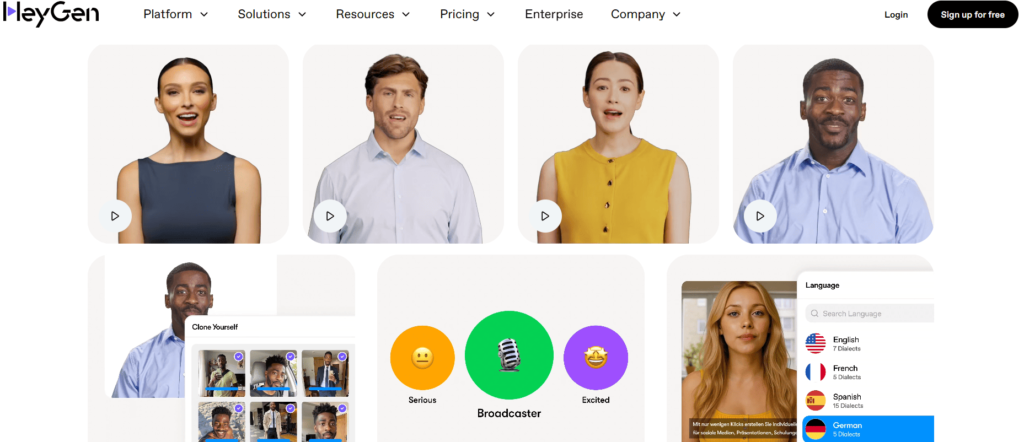
The customizable templates mean you can maintain brand consistency even when you’re producing at volume. Your team members (even the ones who can’t design to save their lives) can create on-brand content without messing it up.
D-ID scales differently. They focus on parallel processing and real-time rendering. Their API can generate thousands of videos simultaneously, which is nuts when you think about it. Processing speeds hit 100 frames per second, so even complex animations render quickly.
Their strength is in personalization at scale. You’re not just making a bunch of similar videos with different text. You’re creating unique, realistic avatars for each use case. Customer service? Interactive training? Virtual consultations? D-ID handles all of it without breaking a sweat.
Language Support: Who Speaks More Fluently?
HeyGen takes this round pretty decisively. Those 175+ languages aren’t just for show. They’ve got regional accents, dialect support, and natural-sounding voices that actually work across all those languages. Creating content for global markets is genuinely simple.
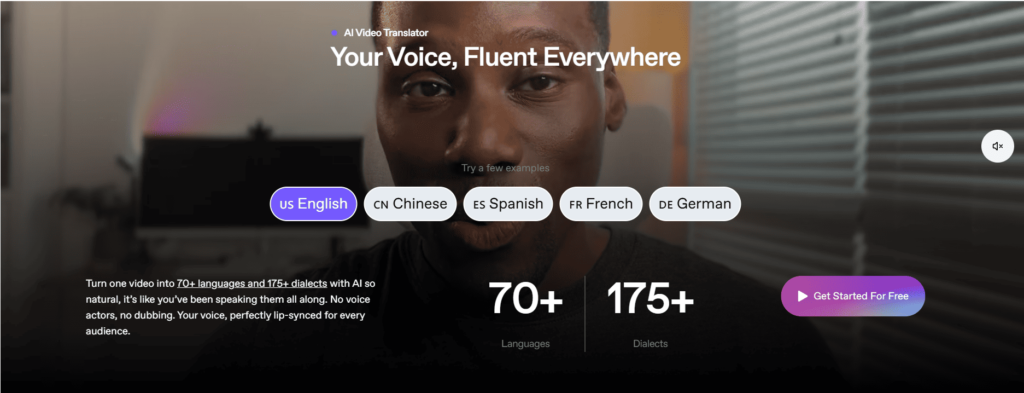
Their voice library has over 300 options, so you can match the voice to your audience. Need a British accent for your UK market and an Australian one for down under? Easy. Want to adjust the tone for a more casual or professional vibe? Also easy.
Voice cloning adds another layer, though it’s limited to certain languages. You can create a custom voice based on audio samples, which is perfect for maintaining brand consistency or personal touch.
D-ID supports 120+ languages, which is still impressive but not quite HeyGen’s level. What they lack in quantity, they make up for in quality and features.
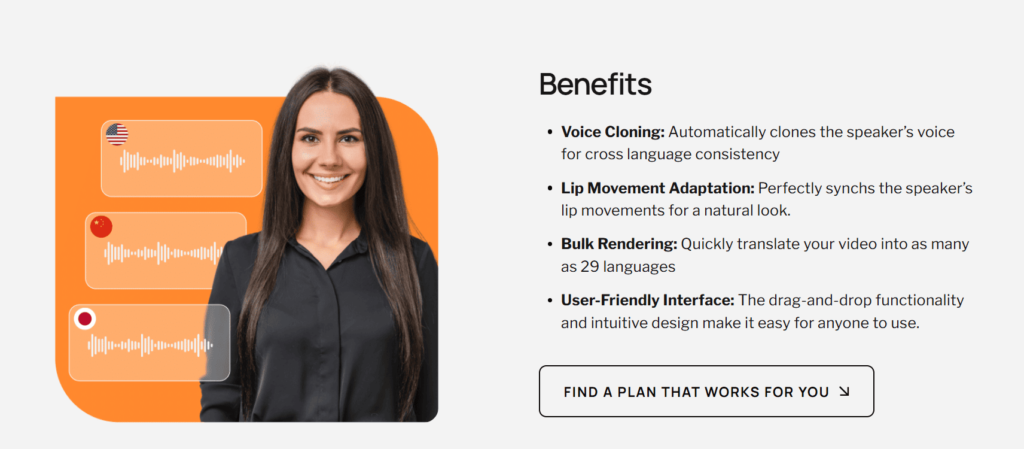
Their voice cloning is seriously good. Record a short message, and their AI replicates your voice with scary accuracy. The avatars maintain perfect lip sync across all languages, which is harder than it sounds.
The real standout? Real-time video translation.
You can take an existing video and translate it into multiple languages while the avatar’s mouth movements match the new words. This isn’t just dubbed audio slapped on top. The facial animations actually change to match the new language. It’s the kind of thing that makes you forget you’re watching AI.
Team Collaboration: Different Philosophies
HeyGen built collaboration right into the platform. Their Spaces feature (available on Team and Enterprise plans) creates shared work environments where your team can actually work together. You get role assignments, permissions, version control, the whole nine yards.
Real-time updates mean everyone sees changes as they happen. No more “wait, which version are we working on?” confusion. Everything’s centralized, which cuts down on the back-and-forth emails and Slack messages.
It’s basically a complete solution if you want your video production happening in one place.
D-ID went a different route. Instead of building collaboration tools, they focused on making their tech integrate into whatever collaboration setup you already have. Their API-centric approach means you add D-ID capabilities to your existing workflow.
No native team features or role management, but honestly? If your team already has a system that works, you probably don’t want to change it anyway. D-ID just enhances what you’re already doing.
Integration Options: Connecting Your Workflow
Both platforms get that nobody wants to work in isolation.
HeyGen’s integration game is strong. Their APIs cover everything: Avatar Video API for bulk generation, Video Translation API for localization, Streaming API for real-time interactions. You can automate pretty much any part of the video creation process.
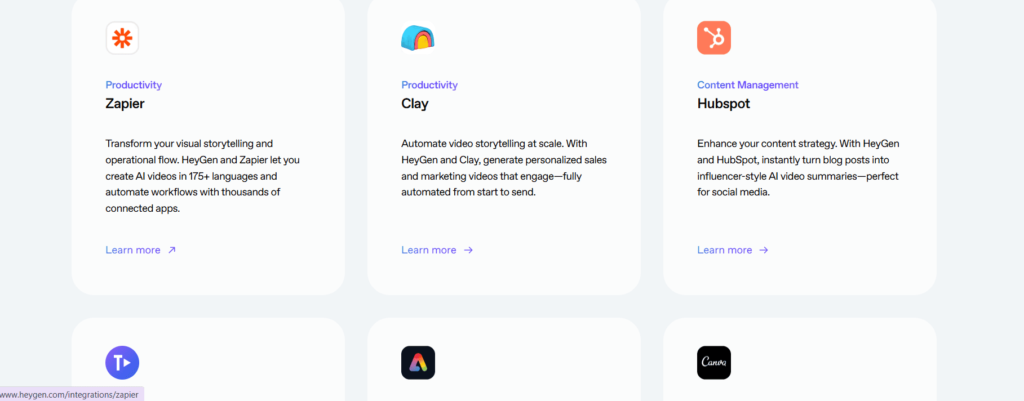
The partnerships are where things get interesting. Canva and Adobe Express integration means you can turn static designs into videos. The ChatGPT integration converts AI-generated text into video content. You can even add interactive avatars to Zoom meetings, which is either incredibly useful or deeply unsettling depending on your perspective.
Zapier connection opens up 5,000+ tools and apps. If you can imagine a workflow, you can probably build it.
D-ID keeps it developer-focused. Their API embeds into existing applications and platforms.
Want to add talking avatars to your app? Their API handles it. Need to integrate AI video into your learning management system? Also covered.
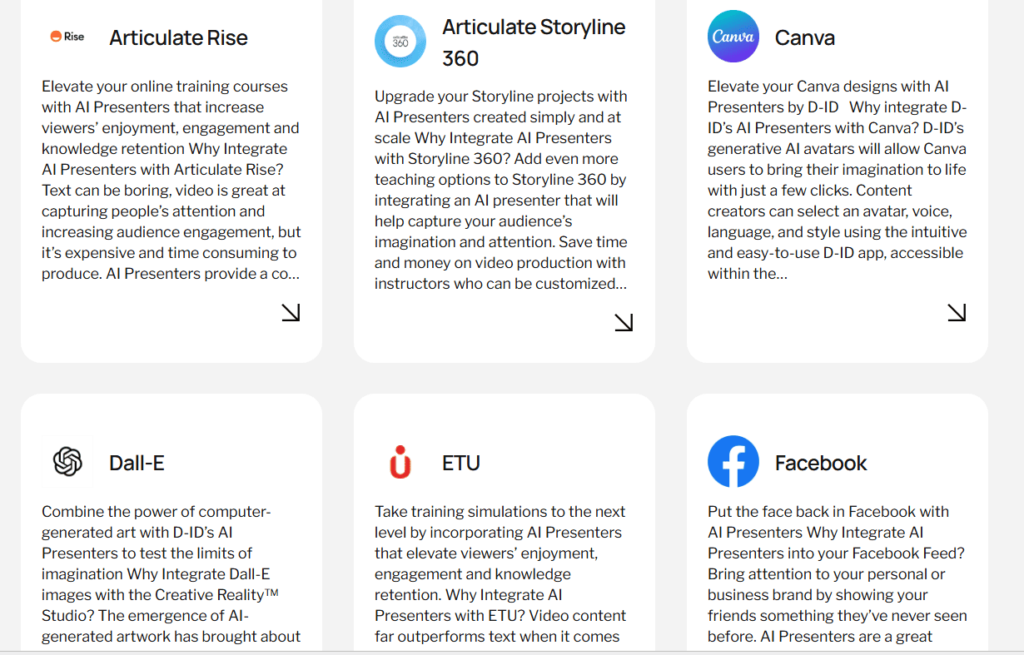
They’ve partnered with Microsoft PowerPoint and Canva, so you can add talking avatars directly to presentations and designs. The TalentLMS integration brings AI presenters into training modules, which makes onboarding content way more engaging than the usual slideshows.
Pricing: What You Actually Pay
HeyGen Pricing
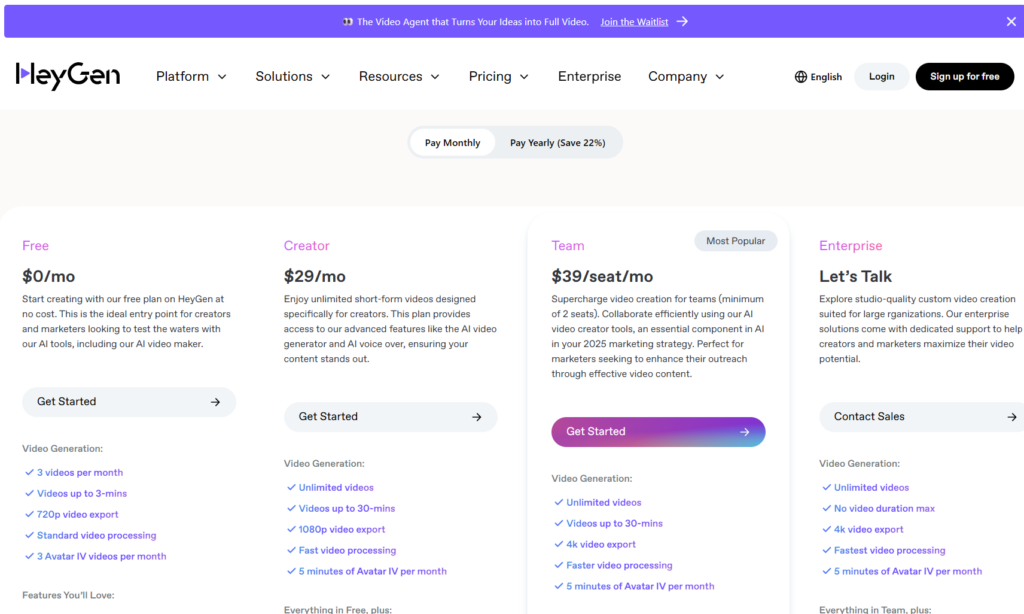
HeyGen structures their pricing in clear tiers:
- Free Plan: Three videos per month, up to 3 minutes each, 720p quality. Good for testing the waters.
- Creator Plan: $29/month (or $24 annually). Unlimited videos up to 5 minutes, one instant avatar, 1080p export, no watermark. Perfect for solo creators.
- Team Plan: $89 per seat monthly (or $69 annually). Unlimited videos up to 30 minutes, custom avatars, brand kits, team workspaces, 1080p quality.
- Enterprise Plan: Custom pricing. Unlimited everything, multiple avatars, 4K exports, the works.
D-ID Pricing
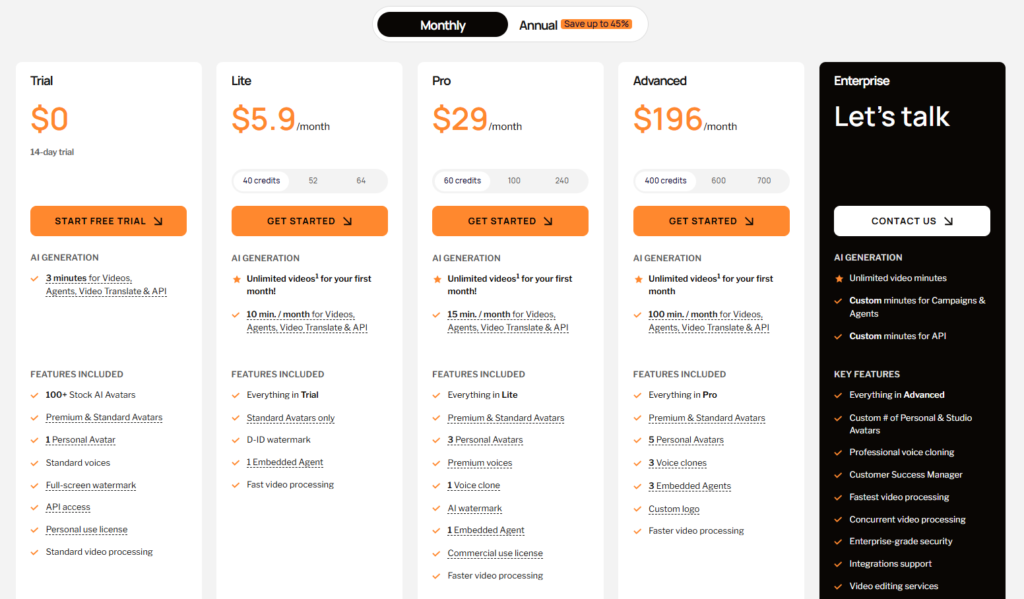
D-ID’s pricing is more granular:
- Trial Plan: Free for 14 days. 5 minutes of video or 10 minutes of streaming, includes watermark.
- Lite Plan: $14.40/month (annual billing). 16 minutes of video or 32 minutes of streaming. Personal use only, includes watermark.
- Pro Plan: $35/month (annual billing). 45 minutes of video or 90 minutes of streaming, commercial license, premium voices, live streaming.
- Advanced Plan: $138.60/month (annual billing). 200 minutes of video or 400 minutes of streaming, custom watermarks, voice cloning, premium support.
- Enterprise Plan: Custom pricing for unlimited everything.
D-ID starts cheaper if you’re just testing things out. HeyGen makes more sense if you’re producing lots of content. Neither is objectively better; it depends on your usage patterns.
The Standout Features Worth Knowing
HeyGen’s Best Tricks:
The text-to-video conversion is stupid simple. Type your script, pick an avatar and voice, hit generate. Done. No video editing skills required.
Generative Outfit feature lets you change what your avatars wear without re-recording anything. Sounds minor, but it’s actually super useful for brand consistency.
The multilingual support isn’t just a checkbox feature. It actually works well across all those languages, which is rarer than you’d think.
D-ID’s Party Tricks:
Creative Reality Studio can animate literally any image. Historical photos, illustrations, brand mascots… if it has a face, D-ID can make it talk. This opens up creative possibilities that aren’t possible with traditional video.
Their AI Agents go beyond simple avatars. These are conversational AI that can discuss specific topics, products, or services while looking and sounding natural. Think virtual sales rep or customer service agent, but way less robotic.
The video translation tech is legitimately impressive. Watching an avatar seamlessly switch languages while maintaining perfect lip sync never gets old.
Personal avatars (their digital twin feature) are hyper-realistic. If you need an avatar that actually looks like you, not just “professional person vaguely resembling you,” D-ID delivers.
So Which One Should You Choose?
Here’s my honest take after using both:
Pick HeyGen if you need to produce lots of videos quickly, want extensive templates and customization options, or need to create content in tons of different languages. It’s the practical choice for marketing teams, content creators, and businesses that need volume without sacrificing quality. The learning curve is gentle, and you can be productive on day one.
Pick D-ID if realism matters more than speed, you need interactive AI agents, or you’re building custom applications that need embedded video capabilities. It’s the right call for customer-facing applications, training programs that need that human touch, or any project where the avatar needs to feel genuinely real.
Budget matters too. D-ID’s entry point is lower, but HeyGen’s Creator plan at $29/month offers more features for solo creators. At the enterprise level, both offer custom pricing, so you’ll need to talk to sales either way.
Wait, There’s a Third Option?
If you’re reading this thinking “I want HeyGen’s ease of use and D-ID’s realism,” let me throw AI Studios (formerly DeepBrain.io) into the mix.
AI Studios sits right in the middle. It’s got an intuitive interface like HeyGen, but the avatars lean more toward D-ID’s realism. Text-to-video support covers 80+ languages, the rendering is fast, and the pricing is actually pretty competitive.
What I like about AI Studios is that it doesn’t force you to choose between simplicity and quality. The avatars look professional without that uncanny valley weirdness. The platform is easy enough for beginners but powerful enough for serious production work.
They’ve also nailed the sweet spot on pricing. Not as cheap as D-ID’s entry tier, not as expensive as HeyGen’s team plans. For small businesses and growing teams, it’s worth a serious look.
The Bottom Line
HeyGen and D-ID are both excellent at what they do. They’re just doing different things.
HeyGen is your production powerhouse. Templates, speed, volume, ease of use. It’s built for teams that need to create lots of content without a huge learning curve.
D-ID is your realism specialist. Lifelike avatars, interactive AI, advanced facial animations. It’s built for applications where the avatar needs to feel genuinely human.
AI Studios? It’s the Goldilocks option. Not too simple, not too complex, just right for a lot of use cases.
Try the free trials. Seriously. Both platforms offer them, and you’ll know pretty quickly which one clicks for your specific needs. What works for your buddy’s marketing agency might be terrible for your e-learning platform, and vice versa.
The right choice is whichever one makes your specific project easier. Everything else is just noise.
Quick Answers to Common Questions
What’s HeyGen actually good at?
Creating high-volume video content quickly. If you need templates, multilingual support, and the ability to pump out professional-looking videos without being a video editor, HeyGen’s your pick. Marketing teams and content creators love it.
Why would I pick D-ID instead?
When realism matters more than speed. Their avatars look and move like actual humans, which makes a huge difference for customer-facing applications, interactive training, or anything where the uncanny valley would kill the experience.
How do the prices compare?
D-ID starts at $14.40/month for basic use. HeyGen starts at $29/month but includes more features at that tier. Both offer free trials. At the enterprise level, you’re talking to sales either way, so pricing depends on your specific needs.
Is AI Studios actually better than both?
“Better” is subjective, but it’s a solid middle ground. Easier than D-ID, more realistic than HeyGen, and priced competitively. Worth trying if neither of the main options feels quite right.